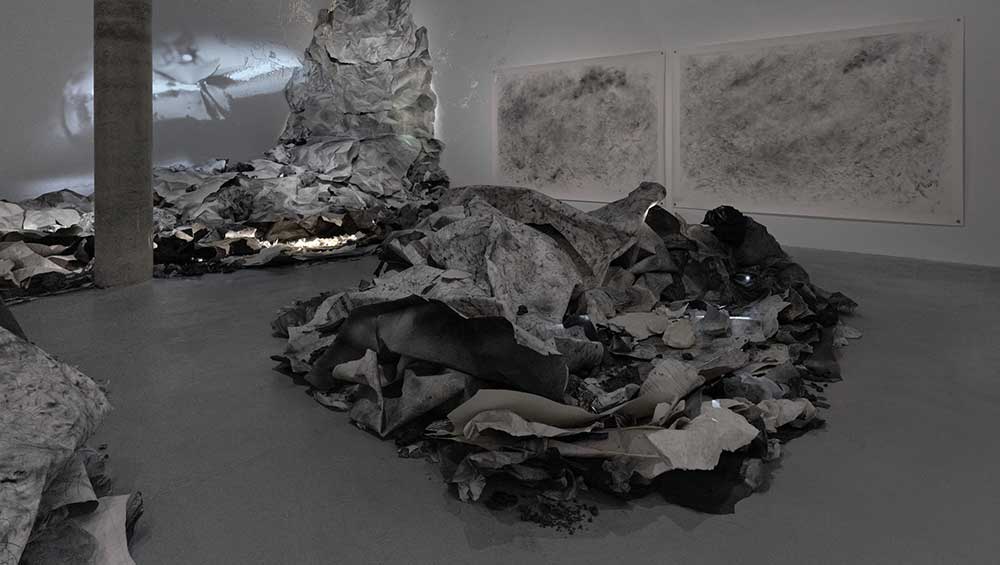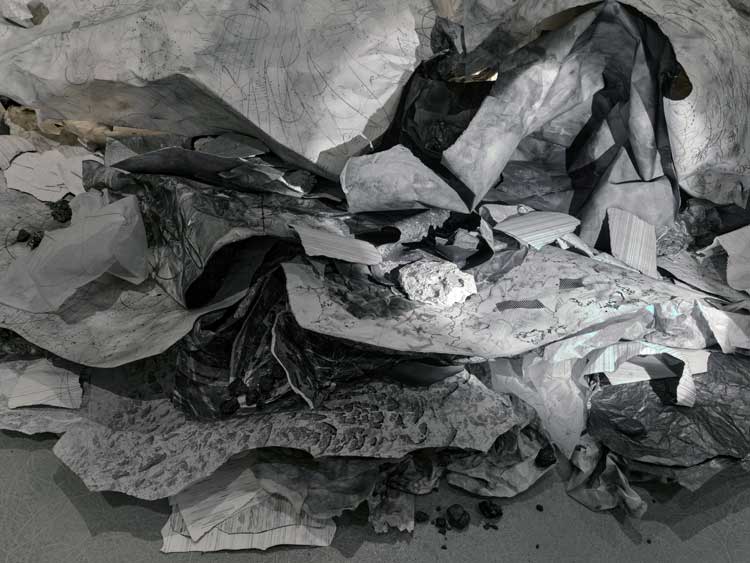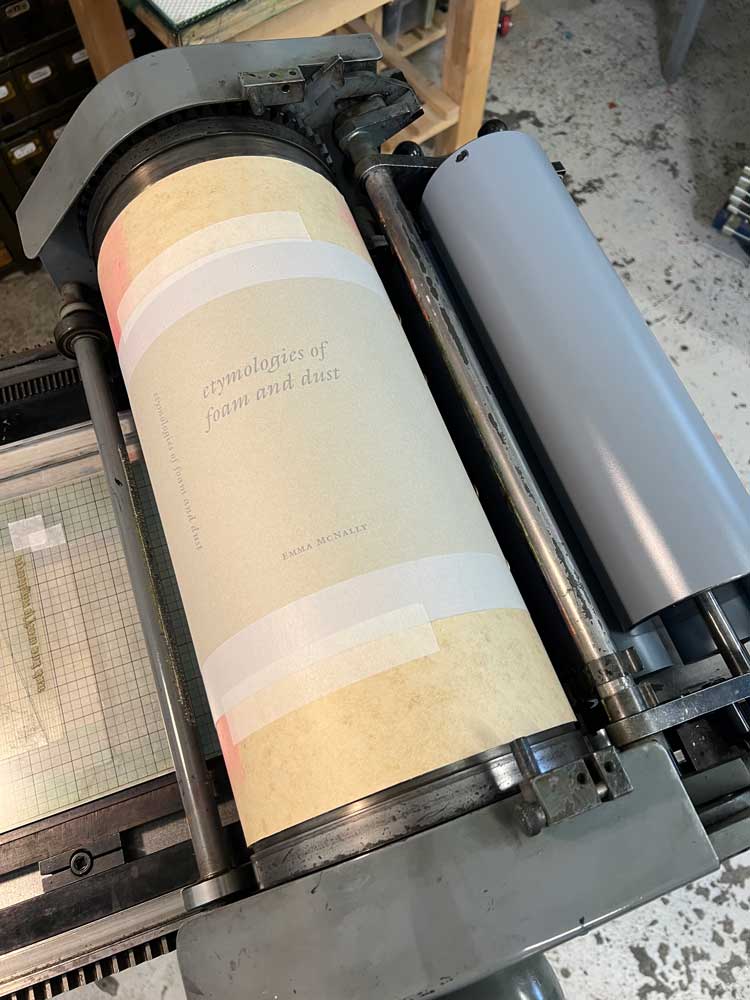
Emma McNally, The Earth is Knot Flat, 2024. Graphite, paper, kaolin, gum arabic. Installation view, Drawing Room/Tannery Arts, London. Photo: Eva Herzog.
Drawing Room/Tannery Arts, London
2 October – 15 December 2024
by BRONAC FERRAN
Combining echoes of the sublime with a strong visual sense of today’s “beyond human” otherness, this new exhibition – her first solo presentation in a public institution – by Emma McNally reveals her to be an artist whose work combines the conceptual, the material and the dialogic. She has transformed the main gallery space at Drawing Room into a landscape where nature, so to speak, is not just remembered but re-enchanted. This is less an exhibition than an environmental installation that draws us in through its variegations of grey and blackness into a manifold otherness. Her intense manipulation of paper pieces assembled together into unearthly constructs, filigreed by multiple hand-drawn lines and textured through modes of crumpling (worked on for months preceding the exhibition), combined with empathic filmic effects by Manon Schwich, make this one of the year’s most enthralling exhibitions.

Emma McNally, The Earth is Knot Flat, 2024. Graphite, paper, kaolin, gum arabic. Installation view, Drawing Room/Tannery Arts, London. Photo: Eva Herzog.
McNally’s engagement with graphite, the malleable natural material that we tend to know best as the lead within our pencils, has become over the last decade a characteristic feature of her practice. It has been used by her in highly “fugitive” fashion, releasing and following its capacity for migratory movement away from the flatness of conventional surfaces. In a wonderful book that accompanies this exhibition, an essay by Aya Nassar points to the significance of graphite as a material to McNally, noting: “As we mark with graphite, graphite marks us, scattering dust suspended in the room.”1 That graphite is crystallised carbon, a natural element that forms the building block of life on this planet and of humanity’s increasingly fragile existence within this, lends a critical edge to these tactile interactions.
Everything in the exhibition has been created with the “raw materials of drawing”, pencil, graphite, arabic gum and kaolin, “upended” on multiple levels. What we perceive at first glance resembles a tumbling landscape of ice-flows, Alpine peaks and crevices, rivulets, glaciers and rockfaces, where: “Surfaces are covered with a carbon patina, caked-on like soot or built up with an accumulation of mark-making … using the hand and machines such as sanders or drills. Smaller works fidgeted together from wires, mesh and crochet are suspended in the air like cobwebbed clouds.”2

Emma McNally, The Earth is Knot Flat, 2024. Graphite, paper, kaolin, gum arabic. Installation view, Drawing Room/Tannery Arts, London. Photo: Bronac Ferran.
This is drawing as energy field, as vibration. The room glistens and shines, we stand around watching or venturing towards zones of incandescent light and probing shadow. Everything has been placed in a specific way. Yet the effect is one of natural, organic, movement. Visitors are offered torches to light their way to closer looking into pools of darkness.
McNally is collapsing hierarchies and notions of beginnings and endings that generally apply within gallery spaces: instead, we, too, are invited to become entangled within a scenario in which all seems to be in a state of interrelation; the atmosphere is of evanescence, formed by rhythmic concordance. Nothing is dominant. Everything is poised in a sway between making and unmaking, holding and collapsing. An adept use of lighting adds to the “sensory ensemble”.3

Emma McNally, The Earth is Knot Flat, 2024. Graphite, paper, kaolin, gum arabic. Installation view, Drawing Room/Tannery Arts, London. Photo: Bronac Ferran.
In 2014, the sculptor Richard Deacon curated a group exhibition at Drawing Room entitled Abstract Drawing. Contributors included McNally, whose practice Deacon associated with a lineage from Hilma af Klint to Eva Hesse, each of whom he views as sharing a quality that he describes as “the coming alive of material”. Within McNally’s work, he sees this as “evidenced through trace, record, pulse, echo, reverberation, resonance, track, scratch, hiss and stutter; … the process of drawing is a kind of index of the ways in which the unseen, the unknown, the deep and the distant are registered on the surface. She is an instrument and the drawing is what the instrument produces or plots.”4
In 2021, these reflexive and responsive qualities were brilliantly realised in a work entitled The River That Flows Nowhere, Like a Sea, which McNally made in Orford Ness in Suffolk. It was a commissioned piece for Afterness, a series organised by Artangel with the National Trust, that invited artists to make works in response to the specific context of the former Atomic Weapons Research Establishment in this location.5 McNally’s contribution was described by a reviewer as “a tremendous work” that resonated perfectly with “the chapel-like interior of the Armoury. A long drift of silvery substance hanging low in the darkened space – shadowy, and occasionally glinting, as if shot through with moonlight – this form is in fact created purely from paper, crumpled and covered with complex graphite drawings invoking the cosmos from atom to planet. Like weather, it seems to change as the light shifts. It might in itself be that desideratum – the artificial cloud.”6
In her recent text, Nassar informs us that for the Drawing Room installation, McNally has reworked the “nine-metre graphic drawing” that was the primary basis of the work in Afterness into another format: “This vast map which McNally had named The River That Flows Nowhere, Like a Sea is now to be folded and crumpled within unflattened earth. The knot holds within it the aftermath … It is up to us to see in that a threat or a promise.” Here, too, McNally melds atomic and cosmic forces into a grounded relation with place, coinciding geomorphic and geomantic narratives into one felt sway of becoming, in an environment in which the place of the human remains contingent and uncertain.
There is also something of this sense of uncertainty and contingency in the way that visitors engage both the works and each other with the exhibition space. On the opening night, many people sit down or stand still and contemplate; others wander and way-find around, tiptoeing about between ridges and edges, staring into points of blackness, as if considering what might lie beyond the abyss.

Emma McNally, The Earth is Knot Flat, 2024. Installation view, Drawing Room/Tannery Arts, London. Photo: Bronac Ferran.
While the atmosphere in the main gallery is of a hushed quietness, those who visit are also invited to enter the nearby Tangle Room where they can chat and venture to make their own drawings on paper or to crumple this as they wish. Already on the opening evening, a group of local schoolchildren aged about 10 had visited and left behind twists and turns of paper hung like edgy birds in lines of flight across the ceiling. This will grow into chains of entangled lines over the course of this exhibition.
McNally began her professional work as an artist working literally on the ground, making large-scale paintings outside tourist attractions, while engaging in open conversation with interested passersby. She began to take random photographs of people from the top floor of a busy east London bus. One of those whom she regularly saw from this vantage point was Gustav Metzger, “collecting the newspaper front pages displayed outside the newsagents at the end of the day and putting them in his trolley”.
McNally then worked with her collaborators in the T1+2 collective and Metzger to install his 100,000 Newspapers project in “a squatted, derelict warehouse” in 2003, the memory of which, as she recalled in a text earlier this year, she felt “definitely resurfacing” in her preparatory “thinking for The Earth is Knot Flat … the convulsed archive: roiling, turbulent, on the move”.7

Emma McNally, Etymologies of Foam and Dust. Book cover in process of letterpress printing. Photo: Joe Hales.
As this exhibition and its accompanying book make visible, McNally’s practice is also (like Metzger’s) in important dialogue with her theoretical writings; the Etymologies of Foam and Dust book with its letterpress-printed covers, designed by Joe Hales Studio in black and grey tones to mirror dimensions of the exhibition, forms an extraordinary contribution to an emergent domain of interdisciplinary writing. As a tool for reflective thinking about language in the context of today’s absorption of this profoundly human domain into the context of technologically led progressions, McNally’s editorial approach in this book will delight many, with its weaving together of archaic sources with an understanding of the shifting currency of certain words – such as “quantum” – in the present. So, too, we learn about the etymology of knots and knotting, and the importance of knots in topology; McNally tells us succinctly: “More than six billion knots and links have been tabulated since the beginnings of knot theory in the 19th century.” Meaningfully, moreover, not least with respect to this exhibition’s title, from the etymologies we learn that with a mathematical knot: “The ends are joined so it cannot be undone.”8
Written like visual prose-poetry, the relationships between the specific words and phrases flow, as McNally has commented, citing another contributor to the publication, Fred Moten, like something of “a babbling brook”.9 She added: “The words were put together in ways that would trigger thinking in non-linear, entangled ways. I scrambled the words with a materially rhythmic feel, trying to generate a rhythmic material feel of the politics (‘quartz’ followed by ‘extraction’) enfolded into the meanings, the way words that masquerade as ‘objective’ are far from innocent, but the potential to scramble and draw attention in oblique ways was what I was exploring, I suppose the practice of ‘reading’ the etymologies encourages an openness to an otherwise of reading, a different sort of reading where words are put into move. The contingency is generative of dynamic and indeterminate thinking, associating, feeling.”10

Emma McNally, Etymologies of Foam and Dust. Book cover in process of letterpress printing. Photo: Joe Hales.
In her illuminating essay threaded throughout the book, interspersed with pages from McNally’s Etymologies and accompanied by images of the artists’ field drawings of graphite markings and crumpled and folded paper, Nassar makes reference to a group of writers and creatives who came together after an explosion of ammonium nitrate at the Port of Beirut in Lebanon in August 2020. It was, as she tells us, “the largest non-nuclear explosion ever recorded” that created a seismic “wave that disturbed the Earth’s upper atmosphere”. This coincided with a growing sense of systems collapse in terms of the boundary conditions of human occupancy of this planet as well as a global pandemic. Nassar points to the group’s collective creation of a document that they titled A Broken Lexicon published last year, observing that: “In the brokenness of words, perhaps something else will emerge; so, a record of brokenness must be written.”11
This comment has now even more urgency in the dark light of the war that is occurring in the same territory. In this sense A Broken Lexicon is a foretelling as, too, seems McNally’s book on various levels. Nassar ends her essay with a reference to another related “speculative text”, entitled M Archive: After the End of the World, that she tells us has been written this year “with Black feminist theory that already inhabits this world of afterness, which McNally crumples into being in this installation”. She continues: “From geocidal violence to ecological catastrophe, we graph known and unknown geographies with something less than mastery, with broken ground with paper whose markings are on the move.”12
Etymologies of Foam and Dust was printed in an initial edition of 300. It is available for £15. Clustered like a star-constellation over two pages are four words, divination, scrying, angel and angle; with McNally reproducing lines from Walter Benjamin’s writing on Paul Klee’s depiction of the Angelus Novus, that ends with the statement: “This storm is what we call progress.”13 Something of this spirit haunts the art and writing of McNally in both this exhibition and publication. Neither should be missed if you are anywhere within reach.
References
1. Graphite geography by Aya Nassar. In: Etymologies of Foam and Dust, edited Emma McNally, Drawing Room, London, 2024, 19-177, (163). See also references 2 and 11, 183.
2. Emma McNally: The Earth is Knot Flat, Drawing Room gallery information sheet.
3. Op cit.
4. This is a citation from Richard Deacon, available here.
5. For further information on the Afterness commissions, see: artangel.org.uk/project/afterness.
6. Artangel: Afterness review – an island of secrets that’s its own work of art by Laura Cumming, the Observer, 27 June 2021.
7. Emma McNally, Gustav Metzger: 100,000 Newspapers, uploaded to Flickr, 3 March 2024.
8. Etymologies of Foam and Dust, 126, 130.
9. Stated in an email conversation by McNally with the author, 11 October 2024. McNally is referring to use of the word “brookish” in the poem In Other Words by Fred Moten, Etymologies of Foam and Dust, 7.
10. Op cit, email correspondence with McNally, slightly edited.
11. Nassar, 103.
12. Nassar, 177.
13. Etymologies of Foam and Dust, 158-160, 160.